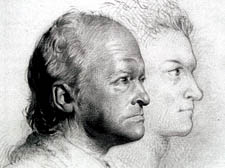|
|
 |
| |

William Blake at 28 and 69 by Frederick Tatham |
Feet that trod my stairs in ancient times belonged to a hero
Ruth Jackson rehabilitates the friend of William Blake who lived in her home 150
years ago
QUITE by accident I discovered that Frederick Tatham, a close friend of the great poet, artist and visionary William Blake, lived in my house 150 years ago.
In 1837, Frederick Tatham inherited all of Blake’s paintings, manuscripts and engravings, and has subsequently been dubbed a villain by historians and scholars alike for what he did with them. But as I unravelled the story, my sympathies towards Frederick Tatham became stronger.
A young man doing a PHd thesis on Blake knocked on the door of my three-bedroomed Victorian terrace in Gospel Oak one day and told me that Tatham, a sculptor and portrait painter, had once lived there. For the next two months I scoured the archives for the full story.
Frederick moved into my house in 1868, together with his family and remained there until he died 10 years later. Art had drawn Tatham to Blake and he, together with other artists like Samuel Palmer and George Richmond, formed a group of painters, calling themselves The Ancients. In a letter, Tatham described Blake as: “Childlike, impetuous, fiery, indomitable, proud and humble.”
Blake died in 1833, leaving his wife Catherine destitute and it was Tatham who took her in as a housekeeper and looked after her. Then when Catherine died four years later, in the arms of Frederick’s wife Louisa, her inheritance was passed on to Tatham.
Scholars of Blake have accused Tatham of selling off Blake’s legacy to auction houses and, worse still, of destroying some of Blake’s manuscripts. It was true that Tatham had sold up to 200 works. The year before he moved to my house he sold 18 works to the British Museum.
But by the time he moved to Gospel Oak, 63-year-old Tatham had fallen on hard times. He rented the house with his sister Harriet and three daughters. Apart from one daughter who was a draper’s assistant, Frederick was the only breadwinner – earning a pittance as minister in a church in Kentish Town – a far cry from his heyday 15 years earlier in Mayfair when his family employed four servants.
Frederick, like his father before him, went bankrupt. His sculpture and portrait studio closed. He was downwardly mobile and with each period of financial decline he sold off more and more of William Blake’s works to support his family.
He died in my house aged 73. Sadly, no Blake canvases were left behind – his paintings are now recognised as masterpieces.
But I am happy with my picture of Frederick Tatham on the wall. After all, he did his best to support his family and friends, so, in my eyes, he’s a hero not a villain. |

|
 |
|
 |
|

